
Vincent Willem van Gogh was a Dutch post-impressionist painter who posthumously became one of the most famous and influential figures in the history of Western art. In a decade, he created about 2,100 artworks, including around 860 oil paintings, most of which date from the last two years of his life. They include landscapes, still lifes, portraits and self-portraits, and are characterised by bold colours and dramatic, impulsive and expressive brushwork that contributed to the foundations of modern art. He was not commercially successful, and his suicide at thirty-seven came after years of depression and poverty.

Sunflowers is the name of two series of still life paintings by the Dutch painter Vincent van Gogh. The first series, executed in Paris in 1887, depicts the flowers lying on the ground, while the second set, made a year later in Arles, shows a bouquet of sunflowers in a vase. In the artist's mind both sets were linked by the name of his friend Paul Gauguin, who acquired two of the Paris versions. About eight months later van Gogh hoped to welcome and to impress Gauguin again with Sunflowers, now part of the painted Décoration for the Yellow House that he prepared for the guestroom of his home in Arles, where Gauguin was supposed to stay. After Gauguin's departure, van Gogh imagined the two major versions as wings of the Berceuse Triptych, and finally he included them in his Les XX in Bruxelles exhibit.

This is a chronology of the artist Vincent van Gogh. It is based as far as possible on Van Gogh's correspondence. However, it has only been possible to construct the chronology by drawing on additional sources. Most of his letters are not dated and it was only in 1973 that a sufficient dating was established by Jan Hulsker, subsequently revised by Ronald Pickvance and marginally corrected by others. Many other relevant dates in the chronology derive from the biographies of his brother Theo, his uncle and godfather Cent, his friends Émile Bernard and Paul Gauguin, and others.

Goupil & Cie is an international auction house and merchant of contemporary art and collectibles. Jean-Baptiste Adophe Goupil founded Goupil & Cie in 1850. Goupil & Cie became a leading art dealership in 19th-century France, with its headquarters in Paris. Step by step, Goupil established a worldwide trade in fine art reproductions of paintings and sculptures, with a network of branches and agents in London and other major art capitals across Continental Europe as well as in New York City and Australia. LesAteliers Photographiques, their workshop north of Paris, in Asnières, was instrumental in their expansion from 1869. The leading figure of Goupil & Cie was Jean-Baptiste Adolphe Goupil (1806–1893). His daughter Marie married the French artist Jean-Léon Gérôme.

This is a list that shows references made to the life and work of Dutch artist Vincent van Gogh (1853–1890) in culture.

The Anne Frank House is a writer's house and biographical museum dedicated to Jewish wartime diarist Anne Frank. The building is located on a canal called the Prinsengracht, close to the Westerkerk, in central Amsterdam in the Netherlands.

Vincent & Theo is a 1990 biographical drama film about the Dutch painter Vincent van Gogh (1853–1890) and his brother Theo (1857–1891), an art dealer. While Vincent Van Gogh's artworks are now famous, he was essentially unrecognised in his lifetime, and survived on his brother's charity. The film was directed by Robert Altman, and starred Tim Roth and Paul Rhys in the title roles.
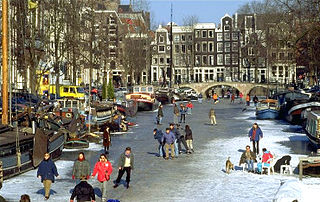
The Keizersgracht is a canal in Amsterdam, the Netherlands. It is the second of the three main Amsterdam canals that together form the Grachtengordel, or canal belt, and lies between the inner Herengracht and outer Prinsengracht.
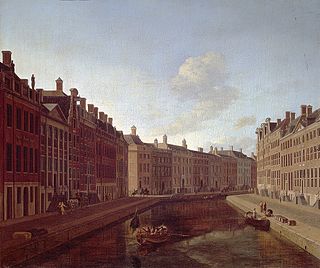
The Herengracht is the second of four Amsterdam canals belonging to the canal belt and lies between the Singel and the Keizersgracht. The Gouden Bocht in particular is known for its large and beautiful canal houses.

Wilhelmina Jacoba "Wil" van Gogh was a nurse and early feminist. She is best known as the youngest sister of the artist Vincent van Gogh and the art dealer Theo van Gogh.

Witsen is the surname of a major family in the history of Amsterdam. Its most notable member was the politician and scholar Nicolaes Witsen, but many other members of the family also held leading roles in trade and politics up until the French occupation of the Netherlands in the late 18th century. It probably originated in Akersloot in Noord-Holland, where Jacob Witsz was a farmer and owned a farmhouse known as ‘de Noord’. A 1774 history of the family states that the family came from Schagerwaard, which had been known as the Witsmeer before it was reclaimed.

Keizersgracht 143 is a canal house on the eastern side of the Keizersgracht between Leliegracht and Herenstraat in Amsterdam. It is a national monument of "very high value" (zeer hoge waarde) and "national distinction" (nationale kenmerkendheid) according to the Dutch Cultural Heritage agency.

The early works of Vincent van Gogh comprise a group of paintings and drawings that Vincent van Gogh made when he was 27 and 28, in 1881 and 1882, his first two years of serious artistic exploration. Over the course of the two-year period Van Gogh lived in several places. He left Brussels, where he had studied for about a year in 1881, to return to his parents’ home in Etten, where he made studies of some of the residents of the town. In January 1882 Van Gogh went to The Hague where he studied with his cousin-in-law Anton Mauve and set up a studio, funded by Mauve. During the ten years of Van Gogh's artistic career from 1881 to 1890 Vincent's brother Theo would be a continuing source of inspiration and financial support; his first financial support began in 1880 funding Vincent while he lived in Brussels.

Paintings of Amsterdam by Vincent van Gogh were made by Vincent van Gogh during a visit in October 1885.
The events that befell the early paintings and drawings by Vincent van Gogh in the period prior to the posthumous recognition of Vincent van Gogh as an innovative artist show how the appreciation of his legacy changed his reputation in a relatively short time.
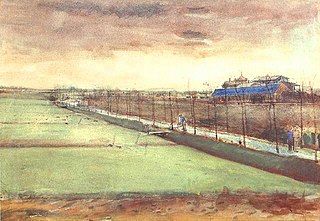
Meadows near Rijswijk and the Schenkweg is a watercolor by the Dutch painter Vincent van Gogh that he made in January 1882, shortly after taking up residence in The Hague.
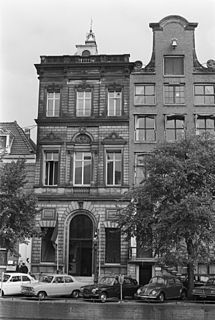
Museum Fodor is a former art museum in Amsterdam in the Netherlands. The museum was located at the Keizersgracht in Amsterdam-Centrum in the building that currently houses the Foam Fotografiemuseum Amsterdam.
Cornelis François Stoop, also known as Cornelius Frank Stoop, was a Dutch-born stockbroker and art collector based in London.
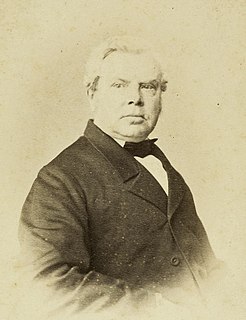
Constant Cornelis Huijsmans was a Dutch art teacher and painter, whose roots go back to the seventeenth-century Antwerp of the landscape painter Cornelis Huysmans (1648–1727). Paintings of the latter are to be found at the Louvre in Paris and at the Hermitage Museum in Saint Petersburg, Russia. Earlier generations of the Huijsmans family used to spell their family name slightly differently, as Huysmans.

Jhr. Johannes Cornelis de Jonge was a Dutch Rijksarchivaris, historian, and politician. He is best known for his encyclopedic Geschiedenis van het Nederlandsche Zeewezen, a naval history of the Netherlands that was based on the Dutch naval archives, a large part of which were destroyed in a fire in the archives of the Dutch Department of the Navy in 1844. By default therefore this history had to come in the place of the lost primary documents.


















